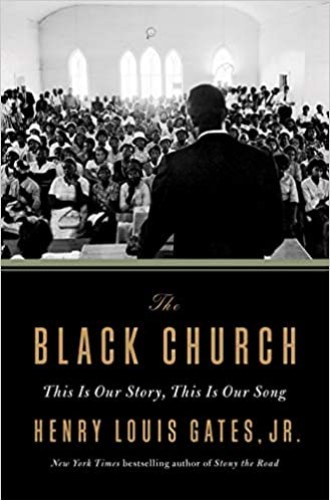Henry Louis Gates celebrates the Black church through history and stories
The companion book to the PBS series is accessible, comprehensive, and joyful.
There is a decidedly blessed assurance within the pages of this book. Henry Louis Gates Jr. tells a story that, by his own admission, he hasn’t told until now—in the confluence of the COVID-19 pandemic, a continuing surge in blatant police brutality, and emboldened White supremacy. It is a song that has echoed for generations, as people of African descent stolen into slavery sought to fashion a faith capable of sustaining them through inhumane and untenable circumstances, many of which shamefully remain to this day.
Along with its companion documentary series, which aired on PBS last month, this book is the culmination of two years of dialogue with a wide range of individuals both within and outside the church—practitioners of the faith along with scholars of history and theology. (For more on the documentary, read or watch Century editor Katara Patton's conversation with series producer/director Stacey Holman.) Woven throughout the text, these voices create a conversational tone as one thought plays against another, reflecting the diversity and density of scholarship that undergirds this ambitious project. Sacrificing neither breadth nor depth, Gates presents a comprehensive history of the Black church in America, paying particular attention to the intersections of race, religion, music, and the struggle for social justice and civil rights.
In the cramped confines of the Middle Passage, people of African descent carried with them a rich cultural and religious heritage which kept them from embracing the Christianity of their captors. Many of their captors had misgivings about encouraging conversion, fearful that it might incite notions about freedom. Nevertheless, in time that African heritage would find its way into the foundation of what would become the Black church. Gates’s attention to the influence of Islam, as well as of Yoruba and Kongo-based religions that amalgamated with Catholicism, is particularly striking.
Gates celebrates the centrality of music not only as a means of expressing religion but also as a strong foundation for its history and development. The tradition of sorrow songs and spirituals, in which African musical styles fused with Protestant hymns, offered a safe way to give voice to the terrible pain and despair of those enslaved. There is more to this music, though, than heartfelt lyrics and rhythmical cadence. Ingrid Monson, a musicologist at Harvard University, talks about its use of blue notes, pitches not found within the rubric of standard Western musical scales. This difference in musical vocabulary provides an apt metaphor for the chasms between Black and White experiences in this country to this day. From a more contemporary vantage point, Gates notes the blurred lines between sacred and secular music resulting from the influence of traditional spirituals as well as gospel music.
Gates’s prose is at once scholarly and accessible, welcoming a range of readers. In the wake of the civil rights movement, James Cone articulated an emerging understanding of Black theology, a through line of the groundwork laid by luminaries such as Henry McNeal Turner and Martin Luther King Jr. In a discussion of the far-reaching influence of Cone’s work, Gates invokes the popular 1970s sitcom Good Times—in the show’s second episode, representation of Jesus as a Black man figures prominently.
From former president Barack Obama’s break with Jeremiah Wright to his inspired rendition of “Amazing Grace” during his eulogy for Clementa Pinckney and the eight others killed in Charleston in 2015, the story takes on increasing urgency. The stakes are heightened as Gates ventures into the state of the world today:
Observing the footage of the vicious murder of George Floyd on the streets of Minneapolis in late May was not only shocking, it was disorienting. So, too, was the lynching of Ahmaud Arbery while he was out jogging in a Georgia suburb, and the brutal senseless killing of Breonna Taylor by police in Kentucky. Was this the year 2020, or 1968, or 1919, or 1876 all over again? In many ways, it was all those years at once, flashing before our eyes, as the pains of our ancestors echoed down to us in the horrifying images of a single Black brother, son, and father with the knee of the law crushing the life out of him.
But suffering, Gates insists, is not the end of the story. “In these shattering times, with a rising generation demanding that their voices be heard, that the dehumanization of Black bodies end, that this be the last lynching, the Black Church once again has been challenged to respond with leadership and grace, resiliency and inspired action.”
In a gentle turn, Gates allows himself a measure of vulnerability in the epilogue. He shares a bit of his personal experience of the Black church as a 12-year-old boy afraid of losing his mother. He wrestles a bit with the personal practice of church, with the emotional power of the Holy Ghost, the beautiful, and the sublime. This wrestling illustrates in a powerful yet practical way why all of this matters beyond Gates’s scholarly pursuits.
There will be instances when the reader’s curiosity is piqued and not satisfied, and so Gates includes an impressive bibliography that spans much of the book’s chronology. He also includes an extensive list of prominent and powerful voices in the African American preaching tradition. An unexpected delight comes from the glossy photographs placed midway through the book, titled “Speakers of the Word.” It’s a beautiful visual representation of many of the men and women celebrated in the book who are, most certainly, “praising the Savior all the day long.”
A version of this article appears in the print edition under the title “Celebrating the Black church.”





